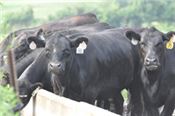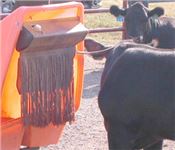Late Summer Cattle Fly Check Can Catch Control Breakdown
DR. LEE TOWNSEND
LEXINGTON, KY.
Horn fly and face fly numbers will continue to build for a few weeks, which will put pressure on control programs. It is a good time to evaluate the pasture fly situation in your herd; check during the early afternoon on a sunny day (Figure 1). Less than 100 horn flies per side and less than 10 face flies per head is a good target for animal protection. Consider an adjustment or supplemental measure if fly numbers exceed these guidelines.
Management
Late season fly control is important. Pasture flies are approaching peak numbers for the season, so their impacts are near maximum levels. Also, exposure of flies to less than recommended rates of insecticide due to less effective treatment selects for resistant individuals and increased chance for control failure. To ensure flys are kept in check, evaluate management options by following suggestions:
Ear Tags
Insecticide-impregnated cattle ear tags can provide 12 to 15 weeks or protection. Effectiveness may be running out in herds that were tagged a little early in the season.
Feed-thru Insecticides
Feed-thru insecticides in mineral supplements require a minimum level of daily consumption by each animal. Be sure that the product is available and that the consumption rate appears to be on-target. This alternative is based on controlling horn fly and face fly maggots that develop only in cow manure. Face flies and horn flies can move a mile or two, so action may be needed to control flies that move in from nearby herds. Provide supplemental control, as necessary.
Self-applicators
Be sure that self-applicators are charged and working. The fly wipe in Figure 2 appears to be dry so the reservoir tank may need to be filled. In some cases, dust can build up enough to reduce the wicking action in wipes and oilers. Be sure dust bags have not been damaged and that the insecticide in them is dry and flowing.
Pour-on
Pour-on and spray applications generally provide about 4 weeks of fly control. Check the last treatment date and be sure doses are measured accurately. ∆
DR. LEE TOWNSEND: Extension Entomologist, University of Kentucky

Figure 1. Evaluate horn fly and face fly control.
Photos: Lee Townsend, UK

Figure 2. Mineral feeder with fly wipe.